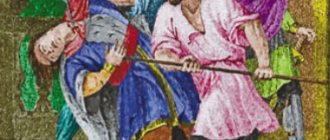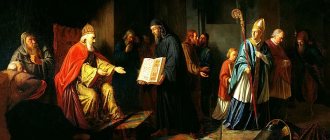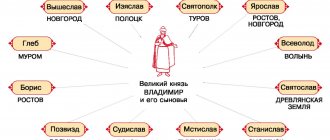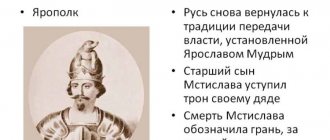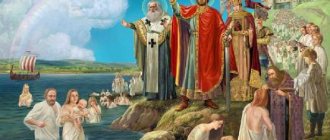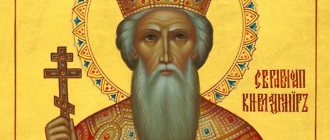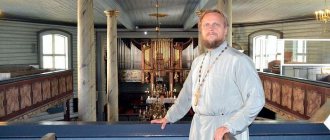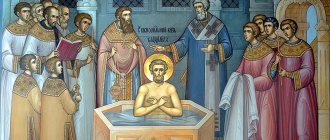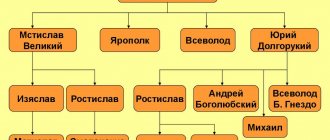The mother of Vladimir, Grand Duke of Kyiv, is not a well-known historical figure. However, it is impossible to classify her as an insignificant historical character.
There are many mysteries in her life. For example, its origin. What is known for sure about Malush? Her brother, the warrior Dobrynya, became the permanent mentor of the future Prince of Kiev, one of the most powerful people, and her son, Prince Vladimir , remained in history as the man who baptized Russia.
Parents
Father
Prince Svyatoslav Khud.
I. Varavin. (about 940 - 972 spring) The son of the Kiev prince Igor Rurikovich and Olga the Wise, Prince Svyatoslav the Brave took part in the first campaign very early - together with his mother, they defeated the Drevlyans who killed Igor and besieged their capital Iskorosten. Perhaps this was the reason for Svyatoslav’s thirst for battles and campaigns later. Almost nothing is known about the relationship between Svyatoslav and his sons. Vladimir spent the first years growing up under the supervision of his grandmother, Princess Olga - she ordered him to be separated from his mother almost immediately after birth, and his father spent more time on military campaigns than in Kyiv.
In 969, before the second campaign in Bulgaria, Vladimir’s father sent him to reign in Novgorod, and his uncle Dobrynya was the prince’s mentor.
Biography of Svyatoslav
Section about Svyatoslav
Mother
“Malusha says goodbye to Vladimir” Hood. S. Efroshkin
Malusha was a housekeeper slave for Princess Olga, and she herself came from Lyubech (therefore sometimes called Malusha Lyubechanka). When Olga found out about the connection between Malusha and Svyatoslav, she angrily exiled Malusha to the village of Budyatino, where Vladimir was born. Almost immediately after the birth of the young prince, he was taken in his grandmother to Kyiv, and no more information is given in the chronicles about the fate of Malusha. Her name appears in the description of the cause of the conflict between the Polotsk princes Rogvold and Vladimir, when Rogvold’s daughter Rogneda, while refusing Vladimir’s matchmakers, contemptuously called Vladimir “rabichich,” i.e. son of a slave. Prince Dobrynya's mentor and uncle, who was Malusha's brother, then took cruel revenge on Rogneda.
What was the mother of the Baptist of Rus' like?
Let's look at the circumstances of Malushi's life.
If we draw a parallel with today, then her position would be comparable to some minor employee in a huge enterprise. What could have happened for the Grand Duke to pay attention to her? Was it only beauty that could captivate him?
Perhaps also the girl's intelligence. After all, the housekeeper was in charge of the household supplies, and this was a troublesome task. You should always keep in mind how much stock you have and where, and what is about to disappear and what is missing. The whole day passes in household chores. You can’t hide from human eyes, you have to be sociable (yes, the word is from modern times, but the quality didn’t appear now). It’s possible that the Grand Duke of Kyiv somehow took a liking to the economical girl.
Wives
Princess of Polotsk Rogneda Rogvoldovna
Rogneda Rogvoldovna
Rogneda was a Polotsk princess, the daughter of Prince Rogvolod. After the defeat of her father and the capture of Polotsk by the troops of Prince Vladimir Svyatoslavich, on the advice of his governor Dobrynya, she was dishonored in front of her parents, after which she was forcibly taken as his wife. In the marriage of Rogneda and Vladimir, 6 children were born, including Izyaslav, the founder of the Izyaslavich dynasty of Polotsk, and Yaroslav the Wise, who won the confrontation for the Kiev throne with other descendants of Grand Duke Vladimir.
More details
Byzantine princess Anna
Byzantine princess Anna Read more
The sister of the Byzantine Emperor Vasily II, Anna was sent as a wife to Prince Vladimir in order to fulfill the terms of peace and an agreement on Russian military assistance to Byzantium.
According to the Tale of Bygone Years, Vladimir, having captured Korsun, demanded his sister from the Byzantine emperors as a wife, threatening to go to Constantinople. Te agreed on the condition of his baptism. When Vladimir accepted this condition, the emperors persuaded Anna to go to the “Tavro-Scythians,” as the Byzantines called the Russians. With tears, the princess said goodbye to her loved ones, saying: “I’m walking like crazy, it would be better for me to die here.”
Other wives
Before his baptism, Vladimir was known as the “great libertine” - he had more than 800 concubines in different cities. In addition, even before converting to Christianity, Vladimir was in pagan marriages. In addition to the above-described Rogneda, the chronicles mention his connections with the “Czech” and “Bulgarian”. In addition, Vladimir made the pregnant widow of his brother Yaropolk, a Greek nun abducted by Svyatoslav during one of his campaigns, his concubine. Soon she gave birth to a son, Svyatopolk.
After baptism, Vladimir was supposedly in two successive Christian marriages - with the Byzantine princess Anna and, after her death in 1011, with the unknown “stepmother of Yaroslav”, who was captured by Svyatopolk in 1018.
From paganism to Christianity
In the Ipatiev Chronicle, under the year 1182, Vsevolod's sister-in-law the Big Nest, therefore Mary's sister, is called Ash. Therefore, we can assume that the Grand Duchess was of non-Russian origin, but belonged to the Yasov tribe. This tribe, like the Polovtsian, roamed the southern reaches of present-day Russia.
The power book calls the Grand Duchess Shvarnovna, or Svarnovna. Most likely, the Jassy prince Shvarn, Mary’s parent, was captured by Roman Mstislavich in 1161, accepted the Christian faith, joined the Russian squad and became a Russian boyar. This assumption may be probable because Prince Izyaslav Davidovich, among whose boyars Shvarn is mentioned, was the father-in-law of his elder brother Vsevolod Georgievich, under whom the future Grand Duke lived in Southern Rus' in his youth.
Maria Yasskaya - Princess of Russia. Drawing by Irina Kokaeva Photo: gorets-media.ru
The first mention of Maria Shvarnovna is found in chronicles in 1175. They married Vsevolod Georgievich in 1174. A year later, Prince Mikhail Georgievich of Vladimir died, and Vsevolod was immediately called to occupy the grand-ducal throne. The people of Vladimir solemnly greeted him and swore to be faithful to him and his children. But Vsevolod Georgievich had to defend his rights with arms in hand for the first seven years of his reign. But then he became the most powerful ruler of the Russian land, pacifying the disastrous feuds of power-hungry princes and in many ways realizing the great idea of his brother Andrei Bogolyubsky about uniting the entire Russian land under the autocratic rule of one great prince. Vsevolod also worked a lot on the peaceful improvement of his regions, built churches and monasteries, and erected fortifications.
But the chronicles also attribute to Mary herself many of the virtues that are praised in her spouse. She was raised “from childhood in the fear of God, she loved the truth, giving honor to bishops, abbots and monks and presbyters, and she loved the monks and gave them what they needed, for she was poor-loving and hospitable; the sad and the needy and the sick, she consoled all of them and gave them what they needed.”
Children
The Tale of Bygone Years conveys Vladimir’s lifestyle before baptism as follows:
“Vladimir was overcome by lust, and he had wives […], and he had 300 concubines in Vyshgorod, 300 in Belgorod and 200 in Berestovo, in the village that is now called Berestovo. And he was insatiable in fornication, bringing married women to him and corrupting girls.”
Thus, it is not possible to find out for certain how many children Vladimir I Svyatoslavich could have had.
Prince Vladimir
The life of Prince Vladimir is divided into two periods - before and after baptism. The first period was very short (up to the age of 25). During this time, Vladimir lived like a pagan. But he quickly matured spiritually. In the second period (until old age), he, like a father, cares about the spiritual and material welfare of his fatherland.
Vladimir, the grandson of Saint Olga, was born around 962. His father was Prince Svyatoslav Igorevich - the grandson of Rurik (but he was the illegitimate son of Svyatoslav). The mother was Malusha Malkovna, daughter of Malk Lyubechanin, whom historians identify with Mal, Prince of Drevlyansky. Having brought the rebel Drevlyans to submission and taken possession of their cities, Princess Olga ordered the execution of Prince Mal, for whom they tried to woo her after the murder of Igor, and took his children, Dobrynya and Malusha, with her. Dobrynya grew up to be a brave, skilled warrior, possessed a state mind, and was subsequently a good assistant to his nephew Vladimir in matters of military and government administration.
Dobrynya Nikitich and Malusha - concubine of Svyatoslav Igorevich, mother of the future Prince Vladimir (Baptist of Rus')
Malusha, a Christian who, however, retained in herself the mysterious darkness of the pagan Drevlyan forests, fell in love with the stern warrior Svyatoslav. She became Princess Olga's housekeeper, i.e. guardian of furs, silver, coins and other valuables. The chronicles say that, angry with her slave, Olga exiled her to the remote village of Budutina. There a boy was born, named by the Russian pagan name Vladimir - who owns the world, who has a special gift of peace. Soon Vladimir was taken away from his mother.
Sergey Efoshkin. Mother and son. Malusha says goodbye to Vladimir
He was brought up in Kyiv, at the court of his grandmother, Princess Olga. But for a long time the contemptuous nickname “robichich,” that is, “son of a slave,” will haunt him.
In 970, Svyatoslav, setting off on a campaign from which he was never destined to return, divided the Russian land between his three sons. Yaropolk reigned in Kiev , Oleg Vladimir reigned in Novgorod .
After the death of Svyatoslav, civil strife began between his children. Sixteen-year-old Yaropolk in 975 marched against his brother Oleg and Oleg died in the battle near the city of Ovruch. Then Yaropolk moved to Novgorod. It is absolutely clear that he wanted to reign alone, without competitors. Vladimir was only 12 years old at that time, and Dobrynya took him “overseas” (to present-day Sweden). Three years later he returned to Novgorod with a foreign army.
Thus began the war between Vladimir and his brother Yaropolk. He led a campaign, in which all pagan Rus' sympathized with him, against Yaropolk the Christian, or, in any case, according to the chronicle, “who gave great freedom to Christians.” In addition, the enmity between the brothers intensified due to the fact that the daughter of the Prince of Polotsk Rogneda, whose hand Vladimir asked for, refused him with these words: “I don’t want to take off my shoes (to take off the groom’s shoes is a wedding ritual; to take off your shoes instead is to marry) the son of a slave,” reproaching him for his low maternal origin, and was going to marry Yaropolk. Insulted, Vladimir captured Polotsk, dishonored Rogneda in front of her father and mother, and then killed both parents. Following this, in the summer of 978, he besieged Kyiv. Yaropolk is locked in the town of Rodnya. After almost two years of siege, hunger forced Yaropolk to surrender to the mercy of his brother. But when Yaropolk entered Vladimir’s chambers, two Varangians standing in the doorway lifted him up with their swords “under their bosom.”
Sergey Efoshkin. Prince Vladimir and Prince Yaropolk
With this villainous murder, Vladimir’s autocratic reign in Rus' began, which lasted for 37 long years.
The chroniclers deliberately do not spare black colors, depicting Vladimir before he accepted Christianity, in order to more clearly indicate the miraculous effect of the grace of baptism, presenting the same prince in the brightest form. He was cruel, vindictive and generally endowed with a variety of vices, among which, first of all, is exorbitant voluptuousness. Vladimir had five wives at that time. One of them is the already mentioned Polotsk princess Rogneda (mother of Yaroslav the Wise) .
Vladimir and Rogneda with their son. ROGNEDA of Polotsk (c. 960 - c. 1000) - daughter of Prince Rogvolod from the city of Polotsk. She was very beautiful. She was going to marry Yaropolk Svyatoslavovich. She refused Prince Vladimir Svyatoslavovich and insulted him, calling him the son of a slave. In 979, Vladimir captured Polotsk, killed her relatives, and made her his wife. In 981 she gave birth to a son, Izyaslav. Around 987 she made an attempt on her husband's life. For this, Vladimir ordered her to dress smartly and wait in the room. She realized that she was in danger, called her son and hid him. When the prince entered with a sword in his hand, little Izyaslav stood up for his mother. Vladimir did not kill Rogneda. He sent her and her son to the city of Svisloch (Izyaslavl). Now this is the city of Zaslavl not far from Minsk. In total, she gave birth to Vladimir 4 sons (among them Yaroslav the Wise) and 3 daughters. In 1000, shortly before her death, she became a monk under the name of Anastasia.
Vladimir’s other wife was the widow of Yaropolk, whom he killed, a certain Greek woman who had previously been a nun and was brought to Kyiv by Prince Svyatoslav, struck by her beauty. From her, by the way, Svyatopolk the Accursed - the murderer of the holy brothers Boris and Gleb. In addition to his legal wives, the prince had hundreds of concubines. “He was insatiable in fornication, bringing to himself married wives and corrupting girls,” this is how the chronicler wrote condemningly about Vladimir. As they say, “lived to the fullest.”
Temple by the lake
In addition, Vladimir was at first a convinced pagan and an ardent opponent of Christianity. Soon after entering Kiev, he built a real pagan pantheon on a hill near his palace - he placed statues of pagan gods: Perun, Khors, Dazhbog, Stribog, Simragl and Mokosha.
“And people worshiped them, calling them gods, and brought their sons and daughters, and made sacrifices to demons... And the Russian land and that hill were defiled with blood,” the chronicle says.
Boris Olshansky. Oath of Svarozhich
Statues of Perun, who by the will of Vladimir became the main deity of ancient Rus', were also installed in other ancient Russian cities. In 983, after one of Vladimir’s campaigns, it was decided to organize human sacrifices on “Perunov Hill”. The lot fell on the court of a certain Christian Varangian, and the Kyiv pagans demanded that his son be sacrificed. The Varangian did not submit to them and did not give his son to be slaughtered to demons. In retaliation, the Kievans swept away his entire yard and cut down the entryway where he stood with his son, and so killed them. These Christian Varangians (late church tradition calls their names: Theodore and his son John) became the first martyrs for the faith in the Russian land.
Sergey Efoshkin. The first Russian martyrs Fyodor and John before their death
The introduction of a single state cult of Perun for the entire country was supposed to personify the unity of the Old Russian state, the primacy of Kyiv and the Kyiv prince.
Pagan temple. The ceremony takes place in the temple. In the center of the temple there are 4 domes Svetovit
With all this, Vladimir during these years shows every concern for strengthening the state. He makes several successful campaigns to the west and east (against the Poles, Yatvingians, Volga Bulgarians, Khazars), subjugates a number of East Slavic tribes (Radimichi, Vyatichi) to the power of Kiev, and annexes the so-called. Cherven cities (Volyn). The various regions of the Russian state are held together by stronger bonds than before. He “grazed his land with truth, courage and reason,” like a kind and zealous owner, if necessary, he expanded and defended its borders by force of arms, and returning from a campaign, he arranged generous and cheerful feasts for the squad and for all of Kiev.
Vasnetsov. Vladimir the pagan
However, the pagan reform, which changed only the external appearance of the old gods, could not satisfy Vladimir. Personal search for faith coincided with the demands of the times. Rus' finally lost the features of the previous military federation of individual tribes and turned into a single state, playing an increasingly important role in European and world politics. All this required changes in the sphere of ideology.
Filatov. The choice of Vera by Prince Vladimir
It was not long before Vladimir came to his faith. The chronicle says that at first the prince received ambassadors from the Volga Bulgarians (Muslims), Latins and Khazar Jews, who invited him to accept their law. Prince Vladimir listened carefully to everyone and asked questions.
Being a Muslim, Vladimir seemed to like the possibility of polygamy both in this life and in the future. It was no coincidence that the Mohammedans emphasized precisely this point of their creed: they were clearly trying to adapt to the morals of Vladimir the pagan. But they did not know that Vladimir had already turned away from paganism in the depths of his soul. Moreover, he could “indulge in all fornication” without converting to another faith... But Vladimir, after a conversation with the “Greek philosopher,” settled on Orthodoxy.
Choosing Faith
According to the chronicle, Prince Vladimir, called by God's Providence to be the baptizer of Rus', was already ready to accept the Orthodox faith from the Greeks, but, being a wise leader, he prepared the people for baptism through frequent conversations about faith at the princely court, by testing faith and sending embassies to other countries . And it was decided to send ambassadors and test each faith on the spot, and for this they chose ten men, “kind and intelligent.” Sending an embassy, he introduced the Russians to the faith, the state of trade, the army, life, and the life of peoples.
And these ambassadors observed in Bulgaria how Muslims pray in the mosque: “Standing there without a belt, making a bow, (the person) sits and looks here and there like a madman, and there is no joy in them, only sadness and a great stench. Their law is not good." The Germans “saw various services in churches, but did not see any beauty.” In Byzantium, in the Constantinople Church in the name of Sophia the Wisdom of God, they contemplated the festive patriarchal service in the full light of the chandelier, with the singing of cathedral choirs.
The ambassadors of the Kyiv prince were stunned by what they saw
“We didn’t know whether we were in heaven or on earth,” the ambassadors said upon returning to Kyiv, “for there is no such spectacle and such beauty on earth, and we don’t know how to tell about it, we only know that God is there with people, and Their service is better than in all other countries. We cannot forget that beauty, for every person, if he tastes the sweet, will not then take the bitter, so we can no longer remain here in paganism.” After listening to them, the boyars said to Prince Vladimir: “If the Greek law had been bad, then your grandmother Olga would not have accepted it, and she was the wisest of all people.”
In 987, at a council of boyars, Vladimir decided to be baptized “according to Greek law.”
According to legend, in exchange for this decision, he was even promised the hand of the sister of the ruling Byzantine Emperor Vasily II, Anna, who by this time was already 26 years old. But the promise was not fulfilled, and therefore Vladimir I had to seek Anna’s hand by military force.
According to the chronicle, in the next 988, Prince Vladimir captured Korsun (Chersonese in the Crimea, which then belonged to Byzantium) with a 6,000-strong army and demanded the Byzantine princess Anna as his wife, threatening otherwise to go to Constantinople. Emperor Vasily II was forced to agree, demanding in turn that the prince be baptized so that his sister could marry a fellow believer. Having received Vladimir's consent to accept holy baptism, the Byzantines sent Anna with priests to Korsun. But having achieved his goal, Vladimir forgot his promise. And then something happened to him that changed his whole life. He suddenly went blind!!! Vladimir walked and moaned for several days. The prince’s screams were terrible when he realized that he could remain disabled forever. Princess Anne then reminded him of his promise and advised him to quickly receive holy baptism. In fear of the Christian God, Vladimir and his squad underwent the rite of baptism. At baptism, Vladimir took the name Vasily, in honor of the reigning Byzantine emperor Vasily II, according to the practice of political baptisms of that time. The miracle of returning vision happened after baptism. The world has changed for him.
Sergey Efoshkin. Prince Vladimir. Baptism
Prince Vladimir experienced a dramatic change in his own life, in his spiritual and moral state. From a passionate, proud pagan, he was reborn into a chaste, meek, unusually merciful and kind person. He even seriously intended to introduce an innovation hitherto unheard of in human history - to abolish the death penalty for robbers, fearing sin.
Before the adoption of Christianity, polygamy was common in Rus'. The Kyiv prince Vladimir had 5 legal wives. Orthodox sources claim that after baptism, the prince released all former pagan wives from marital duties. He offered to choose a husband for Rogneda, but she refused and took monastic vows.
Vladimir himself, after baptism, was married according to Christian rites with the Byzantine princess Anna (+1011) . With this marriage, Vladimir achieved that Rus' ceased to be considered a barbarian people in Byzantium. The dynastic prestige of the Kyiv princes increased. Subsequently, Anna actively participated in the spread of Orthodoxy in Rus', “building many churches.” Her tomb was located in the Church of the Blessed Virgin Mary in Kyiv next to the tomb of St. Vladimir the Baptist.
The baptism of Prince Vladimir with the boyars and retinue in Korsun (Chersonese) was the beginning of the baptism of the entire Russian land! Accompanied by his squad, boyars, and clergy, Prince Vladimir moved towards Kyiv. In front they carried crosses, icons, and holy relics.
Upon returning to Kiev, Prince Vladimir gathered 12 of his sons and, having prepared them to accept the holy faith of Christ, baptized them in a spring that forever received the name Khreshchatyk . Together with them, his entire household was baptized, as well as some boyars, probably from those who had not been to Chersonesus.
Perov V.G. Baptism of Rus'. (second half of the 1870s - early 1880s)
Then Vladimir ordered mass baptism to begin. The baptism of Kiev residents took place in the waters of the Dnieper by Korsun priests. In Kyiv, the baptism of the people took place relatively peacefully, while in Novgorod, where Dobrynya led the baptism, it was accompanied by uprisings of the people and their suppression by force. In the Rostov-Suzdal land, where local Slavic and Finno-Ugric tribes retained a certain autonomy due to their remoteness, Christians remained a minority even after Vladimir (until the 13th century, paganism dominated among the Vyatichi).
Prince Vladimir ordered the destruction of pagan idols everywhere: some were burned, others were chopped up. And the main idol of Perun with a silver head and golden mustache was ordered to be tied to the tail of a horse, dragged to the Dnieper, beaten with sticks for public desecration, and then escorted to the rapids so that no one could pull it out and take it. There they tied a stone around the idol’s neck and drowned it. Russian paganism has sunk into the water...
His alms to the poor knew no bounds. The Russian people nicknamed Vladimir “Red Sun” The famous feasts of St. Vladimir were also a means of Christian preaching; on Sundays and major church holidays after the liturgy, abundant festive tables were set out for the people of Kiev, bells rang, choirs sang praises, and even, according to legend, he ordered food and drink to be transported on carts for the weak and sick.
Prince Vladimir
At the same time, the prince continued to remain a victorious commander, a courageous warrior, a wise head and builder of the state. Under the holy prince Vladimir, Kievan Rus flourished and its influence spread far beyond its borders.
Under Vladimir, large-scale stone construction began in Rus'. The cities of Vladimir (990), Belgorod (991), Pereyaslavl (992) and many others were founded.
Vladimir began to build God's temples. From the first centuries of Christianity, the custom began to erect temples on the ruins of pagan sanctuaries or on the blood of holy martyrs. Following this rule, Saint Vladimir built the temple of Saint Basil the Great on the hill where the altar of Perun was located, and founded the stone temple of the Assumption of the Blessed Virgin Mary (Church of the Tithes) on the site of the martyrdom of the holy Varangian martyrs.
Sergey Efoshkin. At the Tithe Church
The church was built by masters from Byzantium. The Church of the Tithes was most likely built on the model of the Pharos Church at the Great Imperial Palace in Constantinople, where Anna loved to go to prayer services. And although neither the Faros nor the Tithe churches have survived, archaeologists managed to recreate their appearance. The church, 27 meters long and 18 wide, was crowned with five large domes. It was decorated with frescoes and mosaics made of multi-colored glass, as well as jasper. Due to the abundance of marble on the floor and soaring columns with carved capitals, contemporaries called the Tithe Church “marble”. The parapets near the choir, the altar barrier and the cornices at the main windows were decorated with marble. The floor of the altar, in addition to multi-colored marble tiles, was made of tiled tiles. The building itself was made of flat thin bricks covered with white plaster.
In 1007, Saint Vladimir transferred the relics of Saint Equal-to-the-Apostles Olga to the Church of the Tithes. And four years later, in 1011, his wife, an associate of many of his endeavors, blessed Queen Anna, was buried there.
The times of Vladimir were marked by the beginning of the spread of literacy in Rus' - which is associated with Epiphany. Like many other progressive reforms in the Russian land, it was carried out by force. The first teachers in Rus' were both Byzantines and Bulgarians, including those who studied on Mount Athos.
The last years of Vladimir Svyatoslavich’s life were overshadowed by enmity with his eldest sons. In 1013, a conspiracy by Svyatopolk the Accursed against Vladimir, his adoptive father, was discovered. Svyatopolk and his wife and their accomplice, a Polish bishop, were arrested and taken into custody. In 1014, another son of Vladimir, Yaroslav of Novgorod, rebelled, refusing to pay tribute to Kyiv. Then Prince Vladimir announced a campaign against Novgorod, but became seriously ill and died on July 15, 1015 . He ruled the Russian state for 37 years (978-1015), of which he lived 28 years in holy baptism.
The holy relics of Vladimir were placed in a marble shrine, placed in the Klimentovsky chapel of the Tithe Assumption Church next to the same marble shrine of Queen Anna.
During the Mongol-Tatar invasion, the honorable remains of Saint Prince Vladimir were buried under the ruins of the Tithe Church. In 1635 they were found, the venerable head of Saint Prince Vladimir rested in the Assumption Cathedral of the Kiev Pechersk Lavra, small particles of holy relics rested in different places. In the second half of the 19th century, a temple was built in Kyiv in the name of the Holy Equal-to-the-Apostles Prince Vladimir, which is currently a cathedral. And in 1853 a monument was erected.
The name and work of the holy Equal-to-the-Apostles Prince Vladimir is connected with the entire subsequent history of the Russian Church. “Through them we became deified and came to know Christ, the True Life,” St. Hilarion testified. His feat was continued by his sons, grandsons, great-grandsons, who owned the Russian land for almost six centuries: from Yaroslav the Wise, who took the first step towards the independent existence of the Russian Church, to the last Rurikovich, Tsar Theodore Ioannovich, under whom in 1589 the Russian Orthodox Church became the fifth independent Patriarchy.
The celebration of Saint Vladimir Equal to the Apostles was established by Saint Alexander Nevsky after on May 15, 1240, with the help and intercession of Saint Vladimir, he won the famous Nevsky victory over the Swedish crusaders.
Since Prince Vladimir lived before the split of the Christian Church (schism 1054), he is also revered by Catholics.
Material prepared by Sergey Shulyak
Children of Vladimir and Rogneda
Izyaslav I Vladimirovich
Izyaslav I Vladimirovich (980/981 - 1001)
More details
The eldest son of Vladimir the Baptist and Rogneda became the founder of the dynasty of princes of Polotsk, where Izyaslav reigned in 989-1001. Only fragmentary information about the prince remains. 100 years after his death, the chronicler, wanting to explain the reason for the enmity between the descendants of Vladimir, who occupied Kyiv, and those who occupied the Principality of Polotsk, cites a legend about Rogneda’s attempt on Vladimir’s life and about her saving from death by her son Izyaslav. Nevertheless, on the advice of the boyars, Vladimir gave Izyaslav and Rogneda the region of the latter’s father (Rogvolod), that is, Polotsk, in which he built the city of Izyaslavl (now Zaslavl) for them. Izyaslav restored the destroyed Polotsk, moving it to a higher and inaccessible place at the mouth of the Polota River, on its left bank. It is likely that at first his mother Rogneda was his regent.
Yaroslav Vladimirovich the Wise
Yaroslav the Wise. Portrait from the Tsar's title book, 1672. (978 - 1054)
Biography of Yaroslav
Section on Yaroslav
Second son of Vladimir the Baptist and Rogneda. According to legend, he witnessed his father’s attempt to execute his mother for attempted murder. Even as a child, he was sent by his father, first to Rostov, and then to Novgorod. Since 1014, relations between father and son have deteriorated. Yaroslav refused to pay the due tribute from Novgorod and began to gather troops for the upcoming war, but Vladimir soon fell ill and died.
After the death of Vladimir, Yaroslav entered into a bloody internecine war with his brother Svyatopolk the Accursed, in which, as a result of four years of confrontation, he was able to gain the upper hand. Then Yaroslav had to face claims to part of his father’s inheritance from another brother, Mstislav of Tmutarakan.
Despite domestic and foreign policy problems, Yaroslav the Wise was not only able to retain power in the state, but also expanded its borders, strengthened protection against raids by nomads, and was also able to raise the authority of the state among other European countries. The period of Yaroslav's reign is considered the heyday of Kievan Rus.
Vsevolod Vladimirovich
(983/984 - until 1013)
In 988, the Kiev prince Vladimir Svyatoslavich conquered a city called Lodomer on the lands of the Volynians and Buzhans on the right bank of the Luga River. The prince named the city after himself and handed it over to one of his sons, Vsevolod, to manage it. So the third eldest son of Rogneda from Vladimir received Volyn as an inheritance with its center in Vladimir.
There are several versions regarding the fate of the prince: D. Likhachev supported Brown’s hypothesis about the identity of Vsevolod with Vissavald, whom Sigrid the Proud burned in the bathhouse; Brown believed that the Varangian entourage incited the boy to break with his father and took him to Sweden (by that time Vsevolod could have been 11-12 years old); Voitovich considers Brown's version unlikely.
Predslava Vladimirovna
(approx. 983 - after 1018)
More details
One of the eldest daughters of Grand Duke Vladimir the Baptist. In the internecine struggle of the Vladimirovich brothers in 1015-1019, she took the side of her brother Yaroslav the Wise. Predslava was an educated girl - she would later be known for her letters. Predslava lived and grew up with her mother and then her sisters in the village of Predslavin, which was named after her.
In 1015, Grand Duke Vladimir Svyatoslavich died, which marked the beginning of a power struggle between his sons. Later and a number of foreign sources mention that Boleslav I the Brave, called to the aid of Svyatopolk to capture Kyiv in 1018, made Predslava his concubine and took him by force to Poland. After this, her name is not mentioned in the chronicles.
Premislava Vladimirovna
(unknown - 1015)
Almost no information has been preserved. There is indirect evidence according to which this daughter of Vladimir and Rogneda in 1000 married Laszlo the Bald, Duke of Hungary, who owned the lands between the Maros and Gran rivers.
Mstislava Vladimirovna
(978/987 - unknown)
Mstislava is mentioned among the three daughters of Vladimir, taken as concubines by King Boleslav I the Brave of Poland in 1018. According to the assumption of the Polish historian Lyabuda, in Poland the captured daughters of Vladimir the Saint (along with Predslava, several of her sisters were captured) lived in a palace on Lednice Island, and they were not forced to convert to Catholicism.
Around 1025, when Bolesław died, the captives were freed. After this, Mstislav is not mentioned anywhere. She had no family.
Serious illness and founding of the monastery
The Grand Duke's wife, in addition to the pious upbringing of her growing children, also had to do charity work. And Mary fulfilled them with truly Christian love and zeal. In “Russian History from Ancient Times” V.N. Tatishchev says that after the fire of 1185, when, in the words of the chronicler, “the whole city and the churches numbering 30 and 2 and the cathedral church of the Holy Mother of God with a golden dome, which had already been decorated by the blessed Prince Andrei, were burned, then the grand-ducal palace served as a victim of the flame; The Grand Duke immediately became concerned with the restoration of the holy churches and distribution to the poor fire victims from his own estate to build houses, but the princess mostly distributed it to the poor, although her rich clothes were almost all burned.”
All sorrows and disasters served only as a preparatory test for the pious princess.
After the birth of her last son, Maria fell ill with a serious illness and suffered from it until her death for 7-8 years. The Nikon Chronicle and the Degree Book call this illness “great”: “and she lay in weakness for seven years, and did not utter any blasphemous word, but gratefully endured, praying often, and remembered the righteous Job, who said: if we could accept good things from the hand of the Lord, then will we really not endure evil?
In illness, the Grand Duchess turned to God with all her soul and in 1200 she accomplished that great work of piety, which remains inviolable and good to this day. She founded a convent in Vladimir on a mountain above the small river Lybid. In the Book of Degrees, Mary is credited with the actual purchase of land for the establishment of a monastery, and her husband took care of the construction of the church. But the Grand Duchess probably spent a lot of her own money on setting up the entire monastery in addition to the funds spent on it by her husband. She wanted in this monastery to prepare for herself a quiet refuge for the last days of her life and a resting place for her body after death.
Assumption Cathedral of the Princess Monastery, where the tomb of Mary of Vladimir is located. Photo "Call"
Having built a monastery, the long-suffering princess, however, hesitated to settle in it, probably because she wanted not to be separated from her children for the time being and to continue raising them. The historian Tatishchev testifies that the ill princess often called her children together and that “she taught them a lot how to live in peace and love, people have the right to judge.”
Feeling the approach of her death, she called her sons to her and told them her last instructions. This farewell conversation of the dying princess is conveyed by the Degree Book, the Nikon Chronicle and the Life of St. George.
“My dear sons, I want to depart from this light: have love for each other: fear God with all your soul; Bishops, priests and deacons, and every priestly rank, do not be ashamed to bow their heads, because they are the shepherds of the verbal sheep and the leaders of His (God’s) secret table. And in monasteries, try to find the houses of the saints and receive prayers and blessings from them (the saints). Especially do not pass by any monk without bowing. Visit the sick, feed and drink the hungry and thirsty, clothe the naked, keep yourselves clean; Love fasting and prayer, especially alms, for it will place you before God. And bow your head before every elder among you and do not let the powerful offend the lesser, execute judgment (for the defense) of the orphan, justify the widow, have sobriety, hate pride, for it brought down the angels from heaven.”
From a Greek nun, widow of Yaropolk
Svyatopolk the Accursed
Svyatopolk Vladimirovich “The Damned” (c.979-1019)
More details
According to the Tale of Bygone Years, he was born to the widow of Yaropolk Svyatoslavich, a Greek nun captured by Svyatoslav and, after the murder of Yaropolk, taken by Prince Vladimir as a concubine. Vladimir himself recognized Svyatopolk as his son, but indirect evidence (the origin of the name and the further confrontation between Svyatopolk and his brothers) leaves room for a theory about Yaropolk’s paternity. Svyatopolk was married to the daughter of the Polish prince Boleslav the Brave. In the last years of Prince Vladimir’s life, having learned that he wanted to bequeath power to his beloved son Boris, Svyatopolk tried to organize a conspiracy, but was discovered and, together with his wife, was imprisoned. After the death of Vladimir in 1015, Svyatopolk was freed by his supporters and took the Kiev throne. From this moment, a bloody civil strife began, during which three half-brothers of Svyatopolk were killed (according to official history - on the orders of Svyatopolk) - Boris, the Murom prince Gleb and the Drevlyan Svyatoslav.
Children from the Bulgarian Princess Miloliki
Boris Vladimirovich
Boris Vladimirovich - fragment of an icon (ca. 986 - 1015)
More details
According to the initial Kyiv Chronicle, he was born of a Bulgarian mother and during the second division of lands he received Rostov as an inheritance. In 1015, Prince Vladimir fell ill, and Boris was called to Kyiv. Soon after his arrival, it became known about the Pecheneg invasion, and his father sent him with a squad to repel the raid. Boris did not meet the Pechenegs anywhere and, returning back, stopped on the Alta River. Here he learned about the death of his father and about the occupation of the grand-ducal table by his half-brother Svyatopolk. The squad offered to go to Kyiv and seize the throne, but Boris rejected this offer, as a result of which his father’s squad left him and he remained with his closest people. According to official history, Svyatopolk sent Putsha and the Vyshgorod boyars to kill his brother. Boris's body was secretly brought to Vyshgorod and buried there in the church of St. Vasily. Boris was about 25 years old. Later, he and his brother Gleb were canonized.
Gleb Vladimirovich
Gleb Vladimirovich - fragment of an icon (ca. 987 - 1015)
More details
Baptized David, Prince of Murom (circa 1013-1015). According to the official historical theory, after the murder of Boris, Svyatopolk, fearing revenge, decided to kill Gleb as well. Chronicles report that Gleb, having heard about the death of his father, hurried to Kyiv. Down from Smolensk he sailed along the Dnieper in a boat. He had a small squad with him. At Smyadyn, an ambassador from Yaroslav the Wise from Novgorod caught up with him and conveyed the message: “Do not sail further. Your brother Boris was killed by Svyatopolk.”
Hearing this, Gleb began to cry and pray, and in the meantime the killers sent by Svyatopolk arrived, whom he sent to intercept Gleb on the road. Having quietly crept up to the prince's ship, the killers captured it and disarmed all his servants. One of the murderers, named Goryaser, forced the cook Gleb, named Torchin, to kill the prince.
In 1019, when Yaroslav occupied Kyiv, on his order, Gleb’s body was found, brought to Vyshgorod and buried along with the body of Boris at the Church of St. Basil.
From Adelya
Mstislav Vladimirovich
Mstislav Vladimirovich the Brave (c.983-1036)
More details
Around 990/1010 Mstislav was appointed by Vladimir to the Tmutarakan principality. In 1023, while Yaroslav was pacifying the rebellion in Suzdal, Mstislav approached Kyiv, however, he did not besiege the capital and occupied Chernigov. In 1024, near Listven in the Chernigov region, a battle between Mstislav and Yaroslav took place, in which Yaroslav was defeated and fled to Novgorod. In 1026, the brothers made peace in Gorodets, according to which Yaroslav received Kyiv and the right side of the Dnieper, while Mstislav retained the left side with Chernigov and Pereyaslavl.
Subsequently, the brothers made a joint campaign against Poland in 1031, returning the Cherven cities, lost during the internecine war of 1015-1019, to the rule of Kyiv.
Until Mstislav's death while hunting in 1036, Yaroslav preferred to rule from Novgorod.
Stanislav Vladimirovich
(984/987 - before 1015)
Son of Vladimir Svyatoslavich and, presumably, Adelya. According to the later Nikon Chronicle, around 988 Stanislav received Smolensk as an inheritance. Stanislav intervened little in the life of the city, he could not or did not want to fight the Varangians, only twice a year he went to the Krivichi for tribute and sent it to Kyiv.
Obviously, Stanislav died before his father, leaving no offspring. It is worth noting that Stanislav is the only known bearer of this name among the Rurikovichs in the pre-Mongol period.
Sudislav Vladimirovich
(984 — 1063)
More details
Son of Vladimir Svyatoslavich and, presumably, Adelya. Nestor mentions it for the first time in 988. According to the Nikon Chronicle, when the struggle between Yaroslav and his father began, Vladimir separated Pskov from the Novgorod principality and gave it to Sudislav. There is no information about Sudislav’s participation in the Vladimirovich strife of 1015-1019. In 1036, after the death of Mstislav, Yaroslav apparently decided to protect himself from further claims to the Kiev throne and captured Sudislav, putting his brother in prison and liquidating the Pskov principality.
He spent about 23 years in captivity and was released after the death of Yaroslav - in 1059, the “Yaroslavich Triumvirates” took an oath from his uncle and released Sudislav. After his release, he became a monk at the Kiev Monastery of St. George, where he died in 1063.
Other children of Prince Vladimir
Son of Vladimir and the “Czech woman” Vysheslav Vladimirovich
(c. 977 - after 1010)
Prince of Novgorod, the eldest of the sons of Vladimir, from the “Czech” (according to the “Saga of Olaf son of Tryggvi” - Allology, according to Tatishchev - the Varangian Olova, “Norwegian princess Olava”). In 988 (989) he received the Novgorod reign from his father, in which he died, according to Tatishchev - in 1010, and according to Miller - in 1012. His brother, Yaroslav, was transferred to Novgorod from Rostov in his place.
Svyatoslav Vladimirovich Prince Drevlyansky
(c. 982—1015)
More details
Around 990, Svyatoslav received the Drevlyansky principality. In 1015, having learned about the death of Boris and Gleb, Svyatoslav left his capital and tried to flee to the Carpathians. Svyatopolk and his retinue caught up with the prince on the bank of the Opir and gave the order: “Chop them all.” The legend connects the name of the city Skole with this episode. Prince Svyatoslav died in this battle, and his warriors refused to go into the service of Svyatopolk. The daughter (according to another version, wife) of Svyatoslav, Paraskovia (Parashka) took refuge on the top of the mountain and, overtaken by Svyatopolk’s warriors, threw herself off the cliff. Now the mountain is named in her honor Parashka.
Pozvizd Vladimirovich
(before 988 - unknown)
Son of Vladimir Svyatoslavich, mentioned only in the chronicle list. No information about him has been preserved. Some researchers considered him not the son, but the nephew of Vladimir. It is unknown who exactly his mother was, and whether he owned any inheritance in Rus'. According to the Gustino Chronicle, he had possession in Volyn. Time of death is unknown.
Unfading Memory
Soon followed the sad farewell of the Grand Duchess to the monastery she had built. “They carried her on a sleigh,” says the historian Tatishchev, “followed by the Grand Duke and all their children who were then in Vladimir, and a multitude of people. Everyone cried inconsolably, each as if for a mother, for the sake of her wisdom and great mercy and generosity to all.” 18 days after being tonsured as a nun, Mary reposed. She was buried in a niche on the northern porch of the Assumption Cathedral of the monastery she founded. But at a later time, during the construction of the northern aisle of the Assumption Church, the tomb ended up in the Annunciation aisle of the temple.
Grand Duchess Maria was glorified in the Cathedral of Vladimir Saints. In the Assumption Princess Monastery, founded by her, March 19 is celebrated as the day of remembrance of St. Mary of Vladimir. Many believers revere the holy princess, pray to her and receive help from her.
Photo: lubovbezusl.ru
And the place on the northern outskirts of Vladimir, where, according to legend, stood the country palace of Maria Shvarnovna, is still called Maryinka. Now this is a private development area in Vladimir, but once it was a village with a landowner's estate. Perhaps this is the largest monument to the Grand Duchess.
